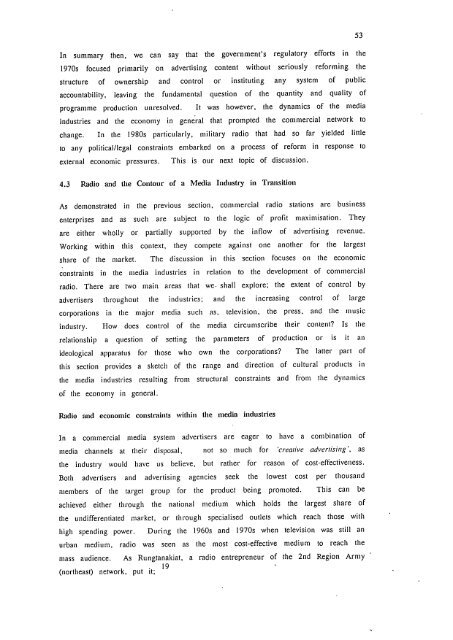iieiiei1eWrkers - Leicester Research Archive - University of Leicester
iieiiei1eWrkers - Leicester Research Archive - University of Leicester
iieiiei1eWrkers - Leicester Research Archive - University of Leicester
You also want an ePaper? Increase the reach of your titles
YUMPU automatically turns print PDFs into web optimized ePapers that Google loves.
In summary then, we can say that the government's regulatory efforts in the<br />
1970s focused primarily on advertising content without seriously reforming the<br />
structure <strong>of</strong> ownership and control or instituting any system <strong>of</strong> public<br />
accountability, leaving the fundamental question <strong>of</strong> (lie quantity and quality <strong>of</strong><br />
programme production unresolved. It was however, the dynamics <strong>of</strong> the media<br />
industries and the economy in general that prompted the commercial network to<br />
change. In the 1980s particularly, military radio that had so far yielded little<br />
to any political/legal constraints embarked on a process <strong>of</strong> reform in response to<br />
external economic pressures. This is our next topic <strong>of</strong> discussion.<br />
4.3 Radio and the Contour <strong>of</strong> a Media Industry in Transition<br />
As demonstrated in the previous section, commercial radio stations are business<br />
enterprises and as such are subject to the logic <strong>of</strong> pr<strong>of</strong>it niaximisation. They<br />
are either wholly or partially supported by the inflow <strong>of</strong> advertising revenue.<br />
Working within this context, they compete against one another for the largest<br />
share <strong>of</strong> the market. The discussion in this section focuses on the economic<br />
constraints in the media industries in relation to the development <strong>of</strong> commercial<br />
radio. There are two main areas that we shall explore; the extent <strong>of</strong> control by<br />
advertisers throughout the industries; and the increasing control <strong>of</strong> large<br />
corporations in the major media such as, television, the press, and the music<br />
industry.<br />
How does control <strong>of</strong> the media circumscribe (heir content? Is the<br />
relationship a question <strong>of</strong> setting the parameters <strong>of</strong> production or is it an<br />
ideological apparatus for those who own the corporations? The latter part <strong>of</strong><br />
this section provides a sketch <strong>of</strong> the range and direction <strong>of</strong> cultural products in<br />
the niedia industries resulting from structural constraints and from the dynamics<br />
<strong>of</strong> the economy in general.<br />
Radio and economic constraints within the media industries<br />
In a commercial media system advertisers are eager to have a combination <strong>of</strong><br />
media channels at their disposal, not so much for 'creative advertising', as<br />
the industry would have us believe, but rather for reason <strong>of</strong> cost-effectiveness.<br />
Both advertisers and advertising agencies seek the lowest cost per thousand<br />
members <strong>of</strong> the target group for the product being promoted. This can be<br />
achieved either through the national medium which holds the largest share <strong>of</strong><br />
(lie undifferentiated market, or through specialised outlets which reach those with<br />
high spending power. During the 1960s and 1970s when television was still an<br />
urban medium, radio was seen as the most cost-effective medium to reach the<br />
mass audience.<br />
(northeast) network, put it; 19<br />
As Rungtanakiat, a radio entrepreneur <strong>of</strong> the 2nd Region Army<br />
53














